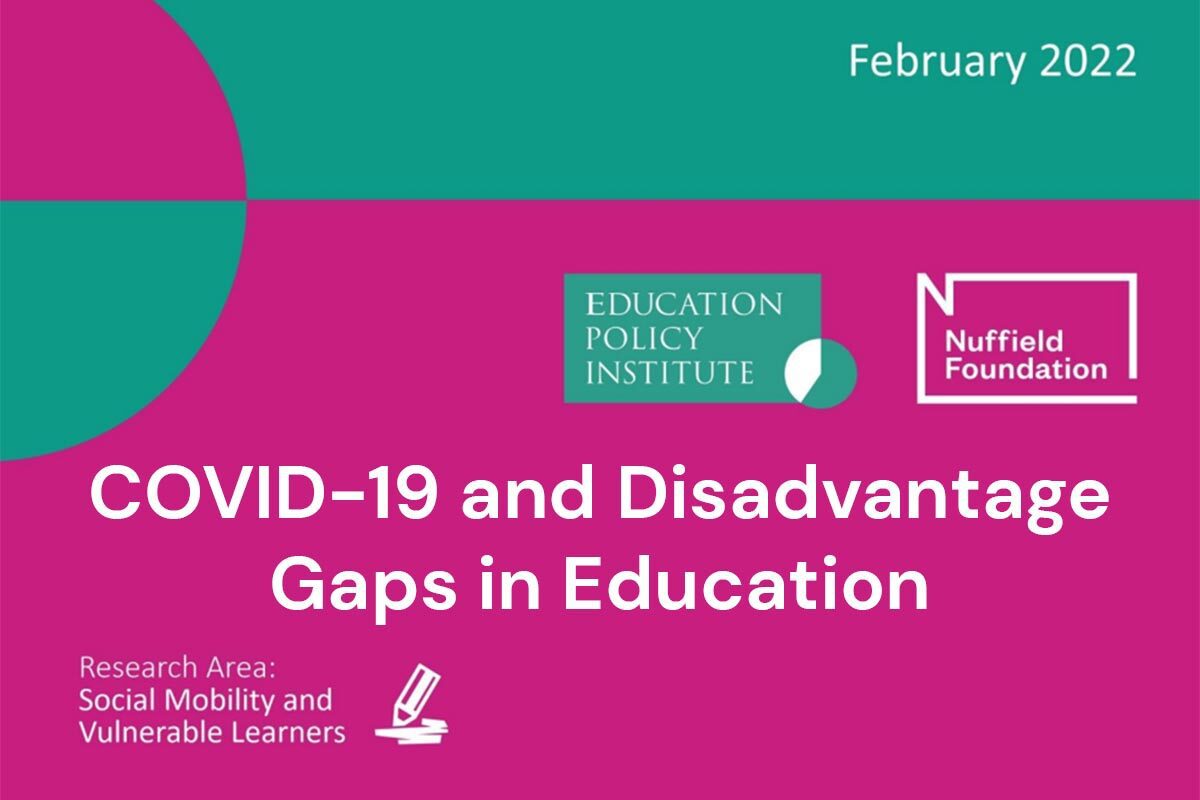“Decade of failure” to improve the disadvantage gap in education

EPI (@EduPolicyInst) report reveals “decade of failure” to improve outcomes of #GCSE pupils in poverty, while disadvantage gap widens for college and sixth form students.
A major “COVID-19 and Disadvantage Gaps in Education” report from the Education Policy Institute (EPI), funded by the Nuffield Foundation, concludes that the government has failed to improve the relative outcomes of students in long-term poverty after a decade of policy interventions.
The new study, which examines the gap in grades between disadvantaged students and their peers, finds that students in long-term poverty trail their more affluent peers by 1.6 grades at GCSE – around the same gap as in 2011.
The ‘disadvantage gap’ is a leading measure of social mobility in England and an indicator of the government’s progress in reducing inequalities in education.
EPI researchers find that not only have large GCSE grade gaps for the most disadvantaged failed to narrow, but more students are now falling into longer term poverty.
Areas in England such as Knowsley, Blackpool and Salford have a high proportion of students trapped in long-term poverty, which is likely hindering their ability to narrow large and persistent education gaps.
The EPI report, which comes after the government has unveiled its Levelling Up White Paper, also gives the first comprehensive picture of the impact of 2020 grades on different students – the year that saw the first switch to teacher assessed grades.
The research finds that concerns teacher assessed grades at GCSE would be biased against disadvantaged students have been largely unfounded, with poorer students seeing similar levels of grade inflation. Students with special educational needs, however, did lose out under this system.
For students in 16-19 education in college and sixth form, the disadvantage gap increased in 2020: poorer students are now 3.1 grades behind their more affluent peers, up from 2.9 grades in 2019.
The growing 16-19 education gap was driven by fewer poorer students taking A levels, which saw a bigger boost from teacher assessed grades than Applied General Qualifications, such as BTECs.
Researchers warn that the lack of progress in narrowing disadvantage gaps across different ages, the rise in students falling into long-term poverty, and entrenched regional inequalities, are likely to severely constrain the government’s “levelling up” ambitions.
The study’s authors also caution that inflated 2020 grades will significantly understate the effects of the pandemic on the “real” educational progress of students – with strong evidence of considerable underlying learning losses which are being masked by awarded grades – particularly for more disadvantaged students.
Sector Response

Dr Mary Bousted, Joint General Secretary of the National Education Union, said:
“The EPI’s report on Covid-19 and the Disadvantage Gap is a verdict on the dismal record of governments over the last decade and more.
“Thirteen years ago Michael Gove told his party conference that ‘schools should be engines of social mobility. They should enable children to overcome disadvantage and deprivation so they can fulfil their innate talents and take control of their own destiny’.Those words ring hollow now.
“Since 2009, we have had years of rhetoric and precious little effective action. Worsening poverty has had what the EPI report is right to call a ‘decisive’ impact on the education of children and young people.4.3million children – or nine in a classroom of 30 – are living in poverty. This speaks of untold hardship endured the length and breadth of the UK.
“Education policies alone are not capable of addressing a problem on this scale – but they can certainly make it worse. Exam factory cultures, and the downgrading of creativity and vocational education have introduced disincentives to learning. In the way they are currently used, grades which are rationed and rely entirely on examinations work to lessen the chances of disadvantaged students.
“It is clear that without fundamental change to Government policy, ‘social mobility’ for these families will remain nothing but a pipe dream. We need to see serious reforms to our education system, invest heavily in education catch-up and as a minimum first step restore the £20 a week that was cut from Universal Credit in October.”

Paul Whiteman, general secretary of school leaders’ union NAHT, said:
“Children from disadvantaged backgrounds are the victims of over a decade of underfunding and neglect by government.
“They have disproportionately suffered from funding cuts not just to education, but to all the wider services that should be there to help them. Successive governments have failed to invest in those who need it the most, and the result is the steady progress that was being made on closing the disadvantage gap has stalled, with no improvement since 2011.
“This report shows clearly that it is not the pandemic that has most impacted disadvantaged students but the years of government failure to address the fundamental issues creating disadvantage.
“Over the last few years, we have seen a new funding formula that directs money away from the most disadvantaged, a pupil premium policy change that has led to the some of the poorest families not receiving funding they should have been entitled to, and a failure to deliver on long overdue SEND reforms.
“And, sadly, the government’s investment into education in the last Spending Review only takes us back to 2010 levels, representing a failure to invest in children’s futures for over a decade.
“In light of all that, talk of ‘levelling up’ starts to sound entirely hollow. If the government is to achieve their stated goal of ‘levelling up’, they need to look carefully at the impact their reforms are having.”

Geoff Barton, General Secretary of the Association of School and College Leaders, said:
“This report shows that poverty and educational outcomes are inextricably intertwined in our deeply unequal society. Put simply, it is difficult for a child to learn if they live cold and hungry lives and face other challenges caused by disadvantage.
“Schools are great agents of social change but they cannot alone overcome the challenges caused by grinding poverty. The government’s levelling up plans and its forthcoming education white paper include measures aimed at improving educational attainment.
“But the scope to narrow the gap between rich and poor will continue to be limited unless this is accompanied by action to tackle the scourge of child poverty. In truth, schools throw the kitchen sink at trying to improve outcomes, not helped by a government which too often thinks that setting some new targets and accountability metrics constitutes meaningful policy.
“The EPI report shows that the government must change the tune – or the gap between rich and poor will remain.
“The lack of funding for 16 to 19-year-olds, over many years, has meant that schools and colleges have had to cut subject choices, teaching hours and enrichment activities. Less well-off students cannot access extra support outside of school and college to fill the gaps and, as a consequence, they have achieved results which are over three grades lower than their more affluent peers.
“This is a persistent disadvantage gap that actually got worse last year and which continues to directly impact on students’ life chances, including their choice of university.
“The extra money that has been recently earmarked for 16-19 students is no more than a finger in the dam and a long way short of stopping this deeply concerning direction of travel. The government must act now to properly finance this very important phase of education.”

Lee Elliot Major, Professor of Social Mobility at the University of Exeter, said:
“The stark persistent gap in outcomes between poorer learners is education’s biggest challenge. We need to think more radically to improve outcomes for disadvantaged learners – that means an explicit unrelenting focus on tackling disadvantage in schools, more engagement with parents, and considering vocational as well as academic options for pupils.”

Bridget Phillipson MP, Labour’s Shadow Education Secretary, commenting on the report detailing the Government’s failure to close the disadvantage gap in education, said:
“As this report makes clear, it is a decade of failed Conservative governments, not just Covid, that have held back the education of millions of young people and made no progress in supporting the most disadvantaged to succeed.
“Ministers cannot disown the legacy of 12 years of failed Conservative policies. The Government’s newly proclaimed focus on the communities hit hardest by their policies amounts to a recycling of old ideas that have failed to deliver for a generation of young people.
“Labour has set out an ambitious, clear and costed Children’s Recovery Plan that matches the scale of challenge post-Covid, alongside a pledge to fill vacancies and skills gaps across the teaching profession ensuring every child has access to the world-class education they deserve. In contrast, Rishi Sunak told us he has ‘maxed out’ on supporting our children.”
The EPIs report has found that the gap in GCSE grades between students in long-term poverty – defined as on FSMs for 80%+ of their time at school – and their better off peers has failed to improve over the last 10 years. The wide educational inequalities uncovered in the study are likely to “severely constrain” the Government’s new Levelling Up plans.
Last year Starmer pledged to launch an education “National Excellence Programme”. The Education committee were ‘unconvinced’ by the £72m opportunity areas programme when it was originally announced in 2017, but the Government’s Education Investment Areas recycle the similar ‘Opportunity Areas’ which are failing to deliver the changes young people need.

David Robinson, report co-author and Director of Post-16 and Skills at the Education Policy Institute (EPI):
“It is deeply concerning that the grade gaps between poorer college and sixth form students and their more affluent peers are now widening. In 2020, disadvantaged 16-19 students were as many as three whole grades behind, and for the very poorest trapped in long-term poverty, this gap grew to as many as four grades.
“Our research findings are very clear: these growing inequalities were driven by A levels gaining more from the system of teacher assessed grades than Applied General Qualifications, which far more disadvantaged students take. The result is that poorer students could have lost out when competing for university places.
“These findings ought to alarm the government, and we hope that urgent action is taken to ensure that students taking BTECs and other alternatives to A levels do not lose out again in 2022.”
Emily Hunt, report co-author and Associate Director at the Education Policy Institute (EPI), said:
“Our research shows that despite government policy interventions, there has been a decade of failure to improve the relative outcomes of students in long-term poverty – with these students still trailing their better off peers by over a full grade and a half at GCSE.
“Not only has this education gap failed to narrow since 2011, but the proportion of poorer students falling into long-term poverty is now on the rise.
“To reverse this tide of stagnating social mobility, the government must do more to address the fundamental drivers of deep-rooted educational inequalities, including poverty.
“This is particularly critical after two years of disruption from the pandemic, where there is strong evidence of significant underlying losses that have not been reflected in students’ teacher assessed grades, with disadvantaged students losing out more.”
Cheryl Lloyd, Education Programme Head at the Nuffield Foundation, said:
“Students from lower income families are less likely to study A levels, which saw larger grade increases in 2020 than applied general qualifications such as BTECs. This means that young people from disadvantaged backgrounds were effectively penalised for not studying A levels, and the disadvantage gap in 16-19 education has become further entrenched.
“The report also shows that disadvantage gaps are greatest in areas of the country that have a large proportion of students in long-term poverty. While the government’s Levelling Up White Paper promises to address geographical disparities, it is important that this is supported by action to address persistent underlying inequalities in the UK, such as poverty, which is having an increasingly detrimental effect on the educational outcomes of young people.”
Key findings
The disadvantage gap at GCSE is large, and outcomes for the very poorest students in long-term poverty have failed to improve after a decade
- The disadvantage gap – the gap in GCSE grades between students on free school meals (at any point over the last six years) and their better off peers – was on average 1.24 grades in 2020. This compares to 1.26 grades in 2019, and is little changed since 2017, marking a stalling of progress in reducing educational inequalities.
- The disadvantage gap is even wider for students who are in long-term poverty (those who spend at least 80% of their school lives on free school meals), who trail their better off peers by as many as 1.6 grades on average at GCSE.
- For this group of the very poorest students who are in long-term poverty, the disadvantage gap has now failed to improve since 2011, despite government interventions.
- There are now more students falling into this long-term poverty 80% FSM group. The proportion of all disadvantaged students that fall into this long-term poverty group increased to 39% in 2020, up from 35% in 2017.
- The proportion of students confined to poverty for their entire school lives – those on FSM for 100% of the time – has also risen, from 19% of all disadvantaged students in 2017 to 25% in 2020.
Disadvantage gaps are much larger in certain areas of England, often where many students spend most of their lives confined to poverty
- There is considerable geographic variation in the disadvantage gap. The five local authorities with the largest grade gaps in 2020 are: Knowsley (poorer students are 1.76 GCSE grades behind); Blackpool (1.69); Salford (1.66); Derby (1.65) and Sheffield (1.61).
- The smallest GCSE grade gaps are in: Kensington and Chelsea (0.10); Westminster (0.29); Newham (0.33); Tower Hamlets (0.34); and Barnet (0.36). Of the 30 areas with the smallest gaps in England, almost all of them are areas in London.
- Areas with the largest disadvantage gaps in the country are more likely to have a large proportion of students in long-term poverty (80% FSM). Several areas have over half of their disadvantaged students in this long-term poverty group, including Kirklees (58%), Sunderland (54%), Halton (53%), Tower Hamlets (53%), Middlesbrough (53%), Knowsley (52%), Kingston-Upon-Hull (52%), and Hartlepool (51%).
- Poverty therefore plays a decisive role, and large disadvantage gaps do not necessarily represent poor educational provision: after controlling for long-term poverty rates, many of these areas see their disadvantage gaps reduce.
- Likewise, controlling for poverty also exposes many areas with low levels of long-term poverty that have underlying poor educational performance. Newham, North Yorkshire, Slough, Rutland, Windsor, Maidenhead, and Milton Keynes all see higher GCSE disadvantage gaps than would be expected.
Despite disadvantage gaps failing to narrow, in 2020 poorer students did not lose out from teacher assessed grades, contrary to fears at the time
- There is no evidence of bias against disadvantaged students in teacher assessed grades in 2020, as was feared; these students made equal grade gains.
- There was even some progress in closing the measured grade gap in 2020 for many minority ethnic groups, including Black Caribbean and other black students, who had been losing ground to White British students prior to 2020.
- But other groups, such as students with special educational needs (SEND), did lose out under teacher assessed grades. The gap between SEND students with severe needs and non-SEND students rose from 3.4 grades in 2019 to 3.6 grades in 2020.
- There is a risk that teacher assessed grades have masked underlying learning losses as a result of the pandemic. There is evidence beyond awarded grades that “real” learning losses for disadvantaged students and other groups have been greater than their peers.
But the disadvantage gap for students in 16-19 education did widen, as more poorer students took qualifications with lower grade increases
- Disadvantaged students in 16-19 education – those attending sixth form and college – were on average the equivalent of 3.1 A level grades behind their more affluent peers across their best three qualifications in 2020, compared to 2.9 grades in 2019.
- Similar to GCSE level, students in 16-19 education in long-term poverty – those who spend at least 80% of their school lives on FSM – saw much larger gaps, and they have now widened significantly. The 16-19 disadvantage gap for students in this long-term poverty group stood at 4 grades in 2020, compared to 3.7 in 2019.
- Sixth form and college students in some regions saw greater increases than in others. Grades increased the most in London and the East Midlands, but students in the North West, Yorkshire and The Humber and the North East only saw modest rises. These regional differences have significant implications for the government’s “levelling up” agenda.
- The widening of the gap at 16-19 is driven by a lower proportion of disadvantaged students taking up A levels, which saw larger grade increases than Applied General Qualifications – which include BTECs.
- All qualifications saw increases in 2020, but A levels increased by one grade more than Applied General grades for otherwise similar students. Applied Generals did not receive a similar boost from the move to teacher assessments as they are partly based on ongoing assessment, practicals and projects – largely completed before the pandemic.
- Because disadvantaged students are more likely to take Applied General qualifications, they may have lost out when competing for university places.
Recommendations for government
- Given that grades awarded under teacher assessments in 2020 may not fully represent students’ underlying learning, government policy must focus on interventions targeted at groups most affected by learning loss during the pandemic.
- The government should prioritise closing gaps for the lowest attaining and most vulnerable students and ensure that the grade increases of 2020 do not distract from the urgent task of tackling deep-rooted educational inequalities, which have failed to improve for several years.
- The government should work with the HE sector to ensure students taking alternatives to A levels do not lose out when competing for university places. This is especially critical for disadvantaged students who already face significant hurdles in accessing HE.
- If the government is serious about reducing educational inequalities, its new Levelling Up Strategy must tackle the social determinants, such as poverty. There is little evidence in current government policy of plans to confront these underlying causes.











Responses